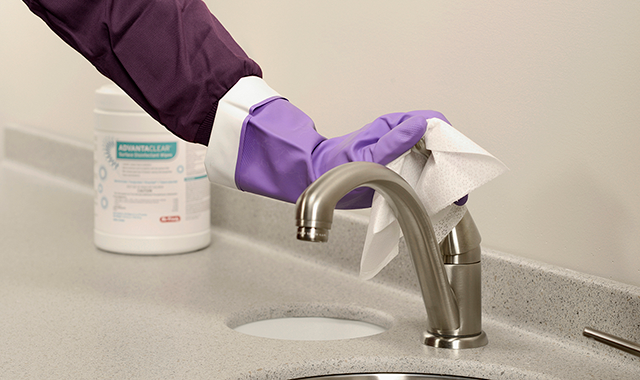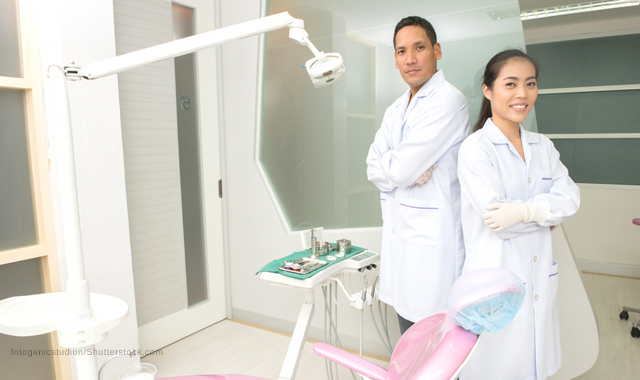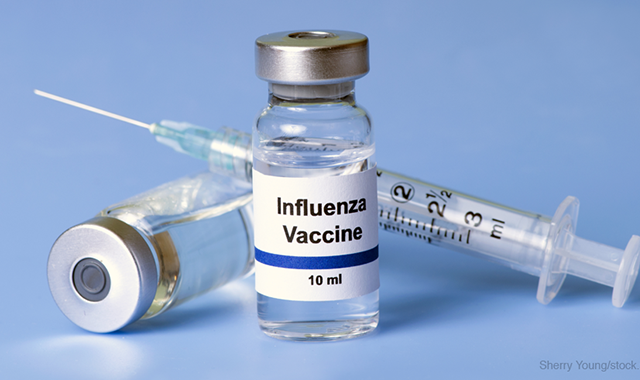5 tips for infection control precautions during flu season
These environmental hygiene tips will ensure your practice remains healthy for all patients throughout the winter.
Cold and flu season is upon us, and dental practitioners need to take extra care to ensure that they stay out of harm’s way.

“It’s crazy, because, on average, adults have two to three colds per year,” says Dr. Sarah Bell-West, scientist for Clorox Healthcare. “And each one of those colds takes seven to 10 days to recover from. Everywhere that we are going, in our homes, in our workplaces, or even if we’re going to a dental practice, we’re really going to be exposed to cold and flu germs.”
Trending article: 3 common infections dental professionals should be worried about
Viruses can exist and spread in areas throughout the practice, whether it be through a careless cough or sneeze, or even from a desktop.
“Environmental hygiene is extremely important, because the influenza virus can survive on a hard surface for up to two days. If you don’t have a robust disinfection program in place at your practice, you are really putting yourself, your staff, the visitors, and the patients at risk for getting another cold or even picking up the flu, especially if they are unvaccinated.”
Click through the slides to learn five precautions dental professionals should take during flu season.


Patient management
A good place to start is by keeping sick people away from the healthy ones, as much as possible.
“What pediatricians have done, and what CDC recommends, is that you have a sick side and well side in the reception room,” says Jackie Dorst, RDH, BS, an infection prevention consultant and speaker. “Patients who are sick sit over on the ‘sick side’, so you congregate them together and then the children that are well are over on the well side, so that they are not exposed to the sick children.”
Dental practices and the pediatrician’s office are, obviously, two different things. But while those practices may seem like an apples-to-oranges comparison, the same infection prevention principles can still apply.
Read more: 5 steps to take after failing an OSHA inspection
“Obviously, a sick child has got to go to the pediatrician for treatment,” she says. “In the dental office, we are different. We don’t have the luxury of having two separate waiting rooms. There’s just one. If you have a patient arrive at your office and they’re showing symptoms of a disease - they’ve got watery eyes, they’re coughing or sneezing, or they look a little flushed, like they might have a fever, then you need to ask them if they are sick. They may say, ‘Oh, no, I don’t think so. I’m just a little fatigued’ or ‘It’s hay fever’. If they have a temperature above 100 degrees, then it would be appropriate to reschedule them until they are no longer running a temperature or their physician says they are not infectious.”
In some cases, it may be an emergency and not possible to reschedule the patient. In those instances, Dorst recommends doing just what is necessary and rescheduling for the remainder of the visit.
“If a patient is in pain, they’ve broken a tooth, obviously the dentist has got to see them,” she continues. “We call it a ‘comfort visit’. If you identify that patient is infectious, then go ahead and take them back into the operatory immediately. Don’t leave them sitting out in the reception room for 45 minutes or an hour until you can work them into your schedule. The entire time that that infected patient is sitting in the reception room, there’s a risk of contaminating other patients that come in, or contaminating the front desk. The dentist can bring the patient back, either smooth off area of a broken tooth, if they have an infection, maybe it would be appropriate to give them an antibiotic, maybe a prescription for some pain medicine, and then once their infection has resolved, then you bring them back for that longer procedure, such as a crown preparation or a root canal, rather than having them spend an hour to two in your office in the infectious stages of a disease.



Products
The product used for surface disinfection matters.
“You want to make sure that you are selecting products that are EPA-registered healthcare disinfectants,” Dr. Bell-West says. “Typically, any product that is labeled as a disinfectant is going to be regulated by the Environmental Protection Agency. Secondly, you want to check the back label to make sure that the product is EPA-registered to kill the influenza virus. There are different strains of influenza virus that are out there. Typically, most products on the market will have claims against Influenza A virus and some products on the market also have claims against Influenza B virus, which are the most common viruses that cause flu in humans.”
A common misstep, she observes, is using a consumer product rather than a healthcare-grade disinfectant.
“It’s really important, especially in dental settings, that they are selecting products that are designed for use in healthcare settings,” Dr. Bell-West says. “The products that you’re getting in a store like a Walmart or a Target are going to be designed for use in the home. And while they may kill or they have claims against cold and flu viruses, they may not be as effective against some of the other pathogens that you may run into in a healthcare facility – something like MRSA, or some of the other antibiotic-resistant pathogens, like Carbapenem-resistant Enterobacteriaceae. Those are very common ones that can easily be spread.”
Related reading: 10 tips for successful enviornmental surface cleaning
Infection prevention measures aren’t just restricted to the operatory.
“Often times, in patient care areas of the dental practice, they are using a healthcare-grade products back in the operatory, but they don’t realize that they should also be using healthcare-grade products in the common areas,” Dr. Bell-West says. “Because, again, pathogens do not exist in isolation. You can imagine if you have a staff member interacting with the patients all day, they may also go into the break rooms, the restrooms, and if they’re infected by a pathogen, then they may be spreading it. You want to make sure that you’re using healthcare-grade products across your facility. That can be your waiting rooms, your reception areas, the staff break rooms as well as the restrooms.
She recommends Clorox Healthcare VersaSure™ Cleaner Disinfectant Wipesas an easy, effective way to disinfect the entire practice.
“It’s going to kill a wide range of pathogens in two minutes or less which is great,” Dr. Bell-West says. “Even though it’s a healthcare-grade product, it also has a low odor and a low residue profile, which really helps in terms of making sure the surfaces are both pathogen-free and they are also looking clean, and that they are acceptable by the people who are using them.”



Protocols
How the practice is disinfected is just as important as the products used.
“Unfortunately, if the whole team is not aware of this, and if the doctor is not empowering the team with it, we can run the risk of, ‘Oh, that patient showed up and we’ve got an hour set aside in the schedule, and if we reschedule them, we’re going to lose that production time,’” Dorst says. “Well, losing that one-hour production time can save you many, many hours of having a team member that’s sick and has to be away from work for two or three days, or you have the flu that runs throughout the office. CDC recommends that if you’re sick, don’t come to work…”
Practices are also advised to have written, standardized protocols that everyone follows.
More from the author: 4 things you NEED to know about waterline disinfection
“Make sure that you have written protocols not only for the operatory, but also for other areas,” Dr. Bell-West says. “In those protocols, you want to talk about what product you are using and who is responsible for the cleaning, and how frequently should they be cleaning and disinfecting.”
Agencies and organizations, like CDC, offer some guidance for disinfection, but it’s really up to the practice to establish its own protocols, based on its unique needs.
“You can just think about your normal workflow and think about, ‘What are the areas we are touching throughout the facility? What are key areas that we want to make sure we clean and disinfect?’” Dr. Bell-West says. “The CDC, as part of their Dental Infection Control Guidelines, provide some really good guidance on what surfaces you should be cleaning. From a frequency standpoint, the CDC doesn’t give as much information on that, they just give rough guidelines. I typically recommend cleaning and disinfecting in the operatory, and that’s essential after every patient. In the waiting areas and the reception areas, you can develop a schedule, but I would definitely recommend at least daily, just because people touch so many surfaces every day. You want to make sure that you cleaning and disinfecting, regularly. They can also reach out to manufacturers for recommendations as well.”



Vaccines
A national trend that can, predictably, lead to the spread of influenza is forgoing vaccinations. Healthcare employers are only mandated to provide one vaccination, but healthcare workers are advised to get others.
“OSHA only requires employer offer the Hepatitis B vaccination, and that provides protection against hepatitis,” Dorst observes. “The other vaccinations are recommended by CDC.”
- Influenza
- MMR
- Varicella
- Tetanus, diphtheria, pertussis
- Meningococcal
Skipping a vaccine puts not only the unvaccinated at risk, but can spread to the rest of society.
More from the author: The dangers of microbial resistance in the dental practice
“Because we have so many children whose parents are not vaccinating them, in the United States we are losing what’s called ‘The Herd Protection’,” Dorst says. “We have those unvaccinated children and, as a result, when we have a highly infectious, communicable disease and those children are not protected, they can acquire the infection. Imagine a young woman who is working as a dental assistant, dental hygienist, or even a dentist – any woman who is of childbearing age – if she’s not fully protected against measles, and a patient comes in with a virus at the very beginning stages of the disease, and that we treat that patient today and then Mom calls back the very next day. ‘Oh, we are going to have to change their next appointment. Johnny broke out with measles the day after we were in your office.’ If that young woman is pregnant, and in the early stages of pregnancy and she acquires an infection because she is not protected, then that can cause a birth defect within the developing fetus. It is a huge risk for the young female dental professionals if they are not protected with the measles, mumps, and rubella vaccination.



Hand hygiene
Maybe the most important piece of advice is not overlooking basic infection prevention practices, like hand hygiene.
“Hand hygiene is so key in terms of preventing the spread of germs,” Dr. Bell-West says. “About 80 percent of infectious diseases are spread via contaminated hands, so it’s really important that you’re doing that. Make sure that your staff has access to high-quality hand care products that are designed for use in healthcare settings – that they’re going to be effective, but they also have aloe and other emollients in them, just to make sure that they don’t dry out their hands. As we are entering into a cold and flu season, there’s less humidity in the air and skin is your best barrier against getting an infection. And if your skin gets dry and cracked, then you’re putting yourself at risk. Making sure that you’re using a moisturizing hand soap can really help with that.”
Related reading: The importance of hand washing in the dental practice
A disinfection station is a good way to provide products for patients.
“I would keep an alcohol hand sanitizer and masks available,” Dorst says. “If the front desk is going to do the initial screening, they should keep disposable, paper thermometers on hand. As far as a disinfectant wipe, to keep in the reception room as a healthcare facility, we should be keeping all surfaces clean and tidy, even in our public areas. I call it, ‘Putting the sparkle and shine’ in your office, because when the surface sparkles and shines, you perceive it as being clean, as being safe.”
Cold and flu season poses a health care challenge every year. But following common sense infection prevention protocols can keep your practice from becoming a nidus of infection.

Maximizing Value: The Hidden Benefits of Preventing Hospital-Acquired Pneumonia Through Oral Hygiene
September 10th 2024Originally posted on Infection Control Today. Hospital-acquired pneumonia (HAP) is a significant infection prevention concern, leading to high patient mortality, increased health care costs, and ICU usage. Oral hygiene is an effective preventive measure.